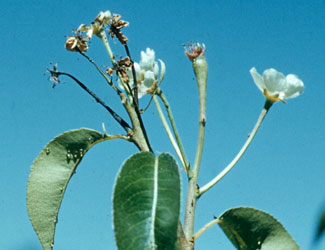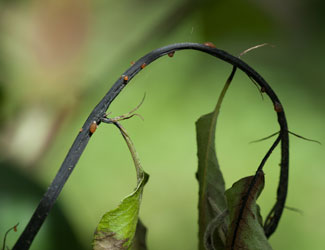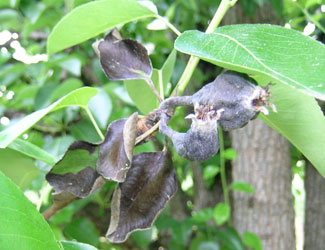-
My established pear tree had a bad case of fire blight this past spring. It has been pruned but some leaves have turned black. Do I prune these out and what else can be done?
Fire blight is a serious disease of plants in the Rosacea family and include trees, shrubs and landscape plantings. Quince, apple, pear, hawthorn, cotoneaster, pyracantha, photinia, flowering almond, plum, cherry and spirea can be affected. The bacterial disease is from Erwinia amylorora and is spread from diseased plants by wind, insects, rain and pruning tools. The disease enters the tree in blossoms and through lenticils. On pears, blossoms become wilted and brown, , the fruitlets look water-soaked and off-colour, become black and shrivel up. Blighted pear shoots (called “strikes”) are black, wilt quickly and often form the shape of a shepherd’s crook near the end. On shoots attached to scaffold limbs or on the trunk, the cankers appear in the structural wood.

The disease can travel, quickly girdling the branches and even the trunk. Amber coloured liquid oozes out of the cankers.

Leaves blacken and fire blight in the root area can be mistaken for crown rot. Trees weaken and die several months after planting in an outbreak.

In the growing season, prune out the current season’s infection 15-30 cm beyond the canker margins in dry weather only. Dip tools in a 10% bleach solution or rubbing alcohol after each cut. Remove prunings and do not compost these. Avoid summer pruning in a serious outbreak to prevent disease spread on new flushes of growth. Don’t use heavy nitrogen fertilisers when succulent growth is most susceptible and irrigate at ground level, not overhead. Fire blight can overwinter and reactivate cankers. Examine the affected tree every few days to spot new infections. Control insects with sucking mouthparts like aphids, leafhoppers and pear phylla.
Products recommended for control of fire blight in Canada include antibiotics, bio pesticides, a growth regulator, and copper sprays. There is no treatment that will cure fire blight after infection has occurred. Timing of blight sprays is critical. Consult the source alpha.gov.bc.ca for information and contact the BC Fruit Testers Association online at bcfta.ca for publications and their library.
Sources
https://www2.gov.bc.ca/gov/content/industry/agriculture-seafood/animals-and-crops/plant-health/insects-and-plant-diseases/tree-fruits/fire-blight?keyword=Fire&keyword=blight
https://extension.uga.edu/publications/detail.html?number=C871&title=fireblight-symptoms-causes-and-treatment
Return to:
Fruit Question page
Diseases Questions page
You Asked Us page
Victoria Chapter page